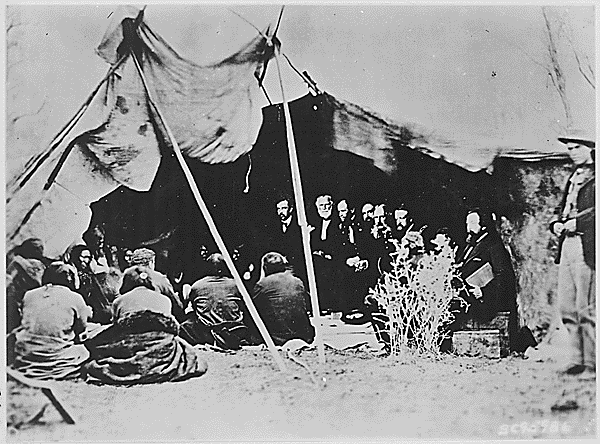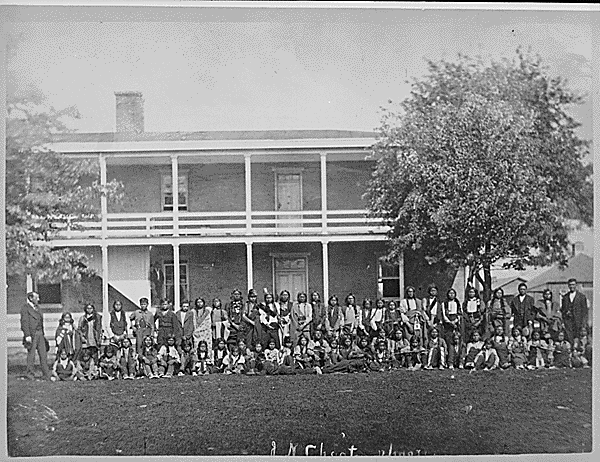History
History is always in the room. Tribes still deal with the direct consequences of historical events every day. The timeline of tribal history, including tribal health practices, extends into the ancient past, long before the advent of the United States. It’s important to know and respect this history.
Each of the eras below capture a glimpse into the political and historical circumstances which have shaped tribal health over the course of millenia. The historical timelines beneath each period contextualize events relative to today, including some significant events in the post-colonization period. While being mindful of this broad history, remember that when you are working with a specific tribe, it is valuable to find out about that tribe’s specific history.
Content Warning
The content provided in this section references historical and contemporary facts related to racism, sexual violence, state violence, abduction, historical trauma, and other emotionally challenging material. This list is not exhaustive. Please proceed cautiously and thoughtfully with this content.
Eras
Roots of Health: Pre-Contact

There is archeological evidence of tribal people living in what is now the northwestern United States for more than 10,000 years. During the long period prior to European contact, tribal people had their own complex traditions, customs, and challenges centering on health care. Indigenous health knowledge continues to inform the practices of tribal communities today in unique ways. It is important to consider the individual context of the tribes and the tribal people one is working with to understand what their health traditions mean to them.
Treaty-making: 1850s–1890s

From the mid to late 1800s, the United States government expanded west, resulting in wars and the forced removal of tribes from their traditional lands. As a result, tribes entered into treaties under duress, trading things of great value, such as large swaths of land, in return for assurances, such as access to health care, and the creation of reservations. Treaties are incredibly important as they outline the United States government’s federal trust responsibility to American Indian and Alaska Native tribes, as well as tribes’ inherent rights as sovereign nations. However, we should not forget that tribes did not enter into treaties willingly, and that the promises made in these treaties have rarely been met. For more information about Northwest-specific treaties, please visit Northwest Treaty Tribes and for more information about treaties across the U.S., please visit the National Archives.
Re-Organization & Forced Assimilation: 1890s–1960s

In the late 19th century through much of the 20th century, American Indian and Alaska Native (AI/AN) people were subjected to organized cultural annihilation, and the violent destruction of their families and communities. Under the Dawes Act, communally held tribal lands that had been protected in treaties were divided up amongst individual AI/AN people. More than 90 million acres of it was given to white settlers. The goal of the act was to force AI/AN people to assimilate with “mainstream” American culture by breaking up the reservations. During this period, AI/AN children were removed from their families and taken to boarding schools where they were punished for speaking in their own language or participating in their own culture. Re-organization and forced assimilation resulted in the relocation of 160,000 AI/AN individuals , primarily to urban areas, between 1952 and 1960 alone. Today, over 70% of AI/ANs live in urban areas and organizations such as the Urban Indian Health Institute have been developed to meet the unique needs of these communities. It’s important to recognize this painful history and respect historical trauma, which has led to the rightful distrust of the government, including those claiming to do good.
Self-Determination: 1970s-Present

Beginning in the 1970s, thanks to advocacy work by tribal governments and organizations, the federal government began making changes that sought to uphold tribes’ rights to self-determination. At this point, tribal nations began taking back control of programs and services for AI/AN people through the federal trust responsibility. For example, in 1976 Congress authorized Medicaid reimbursement and urban Indian health programs, and in 1978 Congress outlawed the removal of children from tribal communities. Despite these changes, tribes continue to have to fight for recognition, respect for their cultures and communities, and the protection of their treaty rights at the local, state and federal level.